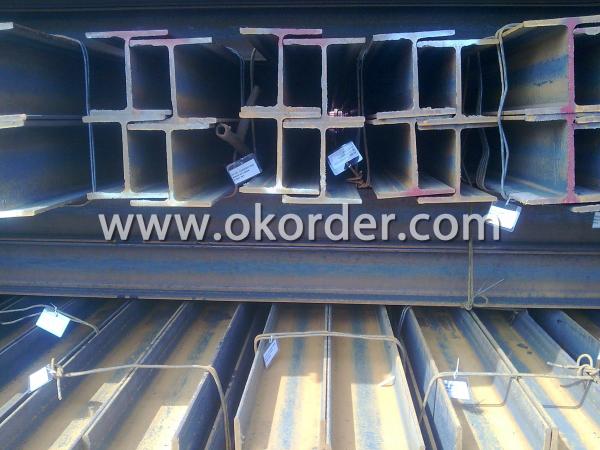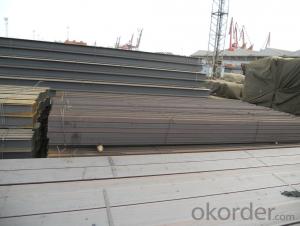Hot Rolled H-Beam Steel
- Loading Port:
- China Main Port
- Payment Terms:
- TT or L/C
- Min Order Qty:
- 50 Tons m.t.
- Supply Capability:
- 1000 Tons Per Day m.t./month
OKorder Service Pledge
OKorder Financial Service
You Might Also Like
Specifications of Hot Rolled H-Beam Steel
1. Standard: JIS G3101
2. Grade: SS400 or Equivalent
3. Length: 6m,10m, 12m as following table
4. Invoicing on theoretical weight or actual weight as customer request
5.Payment: TT or L/C
6. Sizes:
SIZE(mm) | DIMENSION(kg/m) |
100*100 | 16.9 |
125*125 | 23.6 |
150*75 | 14 |
150*150 | 31.1 |
148*100 | 20.7 |
198*99 | 17.8 |
200*100 | 20.9 |
248*124 | 25.1 |
250*125 | 29 |
300*150 | 36.7 |
298*149 | 32 |
200*200 | 49.9 |
294*200 | 55.8 |
346*174 | 41.2 |
350*175 | 49.4 |
244*175 | 43.6 |
175*175 | 40.4 |
294*200 | 55.8 |
298*201 | 64.4 |
346*174 | 41.2 |
350*175 | 49.4 |
400*200 | 65.4 |
396*199 | 56.1 |
450*200 | 74.9 |
446*199 | 65.1 |
340*250 | 78.1 |
500*200 | 88.1 |
300*150 | 36.7 |
Usage & Applications of Hot Rolled H-Beam Steel
Commercial building structure ;Pre-engineered buildings; Machinery support structure; Prefabricated structure; Medium scale bridges; Ship-building structure. etc.
Packaging & Delivery of Hot Rolled H-Beam Steel
1. Packing: it is nude packed in bundles by steel wire rod
2. Bundle weight: not more than 3.5MT for bulk vessel; less than 3 MT for container load
3. Marks:
Color marking: There will be color marking on both end of the bundle for the cargo delivered by bulk vessel. That makes it easily to distinguish at the destination port.
Tag mark: there will be tag mark tied up on the bundles. The information usually including supplier logo and name, product name, made in China, shipping marks and other information request by the customer.
If loading by container the marking is not needed, but we will prepare it as customer request.
4. Transportation: the goods are delivered by truck from mill to loading port, the maximum quantity can be loaded is around 40MTs by each truck. If the order quantity cannot reach the full truck loaded, the transportation cost per ton will be little higher than full load.
5. Delivered by container or bulk vessel
Production flow of Hot Rolled H-Beam Steel
Material prepare (billet) —heat up—rough rolling—precision rolling—cooling—packing—storage and transportation


- Q:What are the design considerations for steel H-beams in multi-story buildings?
- Design considerations for steel H-beams in multi-story buildings include the material's strength and durability, load-carrying capacity, stability and resistance to lateral forces, fireproofing measures, and the need for proper connections and anchoring to ensure structural integrity. Additionally, factors such as cost-effectiveness, ease of fabrication, and constructability should also be taken into account during the design process.
- Q:What are the different connection details for steel H-beams?
- There are several different connection details for steel H-beams, depending on the specific application and structural requirements. Some common connection details for steel H-beams include: 1. Welded Connection: This is the most commonly used connection detail for steel H-beams. It involves welding the flanges and web of the H-beam to the supporting structure or other steel members. Welded connections provide a strong and rigid connection, ensuring proper load transfer between the beams and the supporting structure. 2. Bolted Connection: In this type of connection, bolts are used to connect the flanges of the H-beams to the supporting structure or other steel members. Bolted connections offer ease of installation and flexibility in terms of disassembly and reassembly. They are suitable for applications where the connection needs to be adjustable or removable. 3. Moment Connection: A moment connection is designed to transfer both axial and bending moments between two H-beams. This type of connection is commonly used in multi-story buildings and bridges, where the transfer of significant loads and moments is required. Moment connections typically involve a combination of welded and bolted connections to ensure proper load transfer and stability. 4. Shear Connection: Shear connections are used to transfer shear forces between two H-beams. This type of connection is often used in structures where the shear force is the primary concern, such as in roof trusses or floor systems. Shear connections can be achieved through welding, bolting, or a combination of both. 5. Splice Connection: A splice connection is used to join two or more steel H-beams together to create longer or larger structural members. Splice connections can be achieved through welding or bolting, depending on the specific application and design requirements. Splice connections are commonly used in long-span structures, such as bridges and roof trusses. It is important to note that the selection of the connection detail for steel H-beams depends on various factors, including the structural design, load requirements, and the type of forces expected to act on the structure. The choice of the connection detail should be made in accordance with relevant structural codes and standards to ensure the safety and performance of the structure.
- Q:Can steel H-beams be used for warehouses?
- Yes, steel H-beams can be used for warehouses. Steel H-beams are commonly used in the construction industry for their strength, durability, and ability to support heavy loads. They provide structural stability and allow for open and flexible floor plans in warehouse construction.
- Q:How do steel H-beams perform in coastal environments?
- Steel H-beams perform well in coastal environments due to their inherent resistance to corrosion. The steel used in H-beams is often coated or galvanized, providing an extra layer of protection against the corrosive effects of saltwater and humidity. This makes them highly durable and capable of withstanding the harsh conditions typically found in coastal areas, making them an ideal choice for construction projects in such environments.
- Q:Can steel H-beams be used for supporting mining infrastructure?
- Yes, steel H-beams can be used for supporting mining infrastructure. Due to their high strength and durability, steel H-beams are commonly used in mining applications to provide structural support for tunnels, shafts, and other underground infrastructure. Their load-bearing capacity and resistance to harsh mining conditions make them suitable for ensuring the stability and safety of mining structures.
- Q:How do steel H-beams perform in corrosive environments?
- Steel H-beams perform well in corrosive environments due to their high resistance to corrosion. The protective oxide layer that forms on the surface of steel helps prevent further corrosion, making them a reliable choice for such conditions.
- Q:What are the considerations when transporting or handling Steel H-Beams?
- When transporting or handling Steel H-Beams, there are several key considerations to keep in mind. Firstly, it is important to ensure the beams are securely fastened and properly balanced during transportation to prevent any shifting or tipping. Additionally, the beams should be protected against damage from impacts, vibrations, and adverse weather conditions by using appropriate packaging or covering them with suitable materials. It is crucial to use the correct lifting equipment and techniques to avoid overloading or damaging the H-Beams. Furthermore, the personnel involved in the transportation and handling process should be adequately trained and equipped with personal protective equipment to ensure their safety. Regular inspections and maintenance of the equipment used for transportation are also necessary to minimize any potential risks and ensure the integrity of the H-Beams.
- Q:Can steel H-beams be used in residential construction?
- Yes, steel H-beams can be used in residential construction. They are commonly used as structural components in the construction of residential buildings due to their high strength and durability. Additionally, steel H-beams provide excellent load-bearing capabilities, making them suitable for supporting heavy loads in residential structures.
- Q:Are steel H-beams suitable for commercial or industrial buildings?
- Yes, steel H-beams are commonly used in commercial and industrial buildings due to their numerous advantages. Firstly, H-beams provide excellent structural support and can withstand heavy loads, making them ideal for large-scale buildings such as warehouses, factories, and office complexes. Their high strength-to-weight ratio allows for the construction of longer spans and taller structures, maximizing usable space and minimizing the number of columns required. Additionally, steel H-beams are durable and resistant to various environmental factors, such as fire, moisture, and pests. They also offer flexibility in design, allowing for easy modifications and expansions in the future. Moreover, steel is a sustainable and recyclable material, making it an environmentally friendly choice for construction. Overall, steel H-beams are a reliable and cost-effective solution for commercial and industrial buildings, providing both structural integrity and design versatility.
- Q:What are the different types of connections used for steel H-beams to concrete?
- There are several different types of connections used for steel H-beams to concrete. Some of the most common ones include: 1. Welded connections: This involves welding the steel H-beam to embedded steel plates or angles in the concrete. It provides a strong and rigid connection, but it requires skilled labor and may be more time-consuming. 2. Bolted connections: In this method, the steel H-beam is connected to the concrete using bolts. It is a versatile and relatively easy method, allowing for adjustment and easy disassembly if needed. 3. Shear connectors: These are typically used in composite construction, where the steel H-beam acts together with the concrete to resist loads. Shear connectors, such as headed studs or profiled steel plates, are welded to the steel H-beam and embedded in the concrete to transfer shear forces between the two materials. 4. Mechanical connections: These connections use specialized mechanical devices, such as steel connectors or clamps, to join the steel H-beam to the concrete. They are often used for temporary or removable structures, as they allow for quick installation and removal. The choice of connection type depends on various factors, including the specific project requirements, load capacity, construction method, and budget. Consulting with a structural engineer is essential to determine the most suitable connection type for steel H-beams to concrete in a particular application.
1. Manufacturer Overview |
|
|---|---|
| Location | Tangshan, China |
| Year Established | 2007 |
| Annual Output Value | Above US$ 80 Million |
| Main Markets | Mid East; Southeast aisa; korea |
| Company Certifications | |
2. Manufacturer Certificates |
|
|---|---|
| a) Certification Name | |
| Range | |
| Reference | |
| Validity Period | |
3. Manufacturer Capability |
|
|---|---|
| a)Trade Capacity | |
| Nearest Port | Tianjin; |
| Export Percentage | 20% - 25% |
| No.of Employees in Trade Department | 11-15 People |
| Language Spoken: | English; Chinese |
| b)Factory Information | |
| Factory Size: | Above 75,000 square meters |
| No. of Production Lines | 1 |
| Contract Manufacturing | OEM Service Offered; |
| Product Price Range | Average |
Send your message to us
Hot Rolled H-Beam Steel
- Loading Port:
- China Main Port
- Payment Terms:
- TT or L/C
- Min Order Qty:
- 50 Tons m.t.
- Supply Capability:
- 1000 Tons Per Day m.t./month
OKorder Service Pledge
OKorder Financial Service
Similar products
New products
Hot products
Hot Searches
Related keywords


























